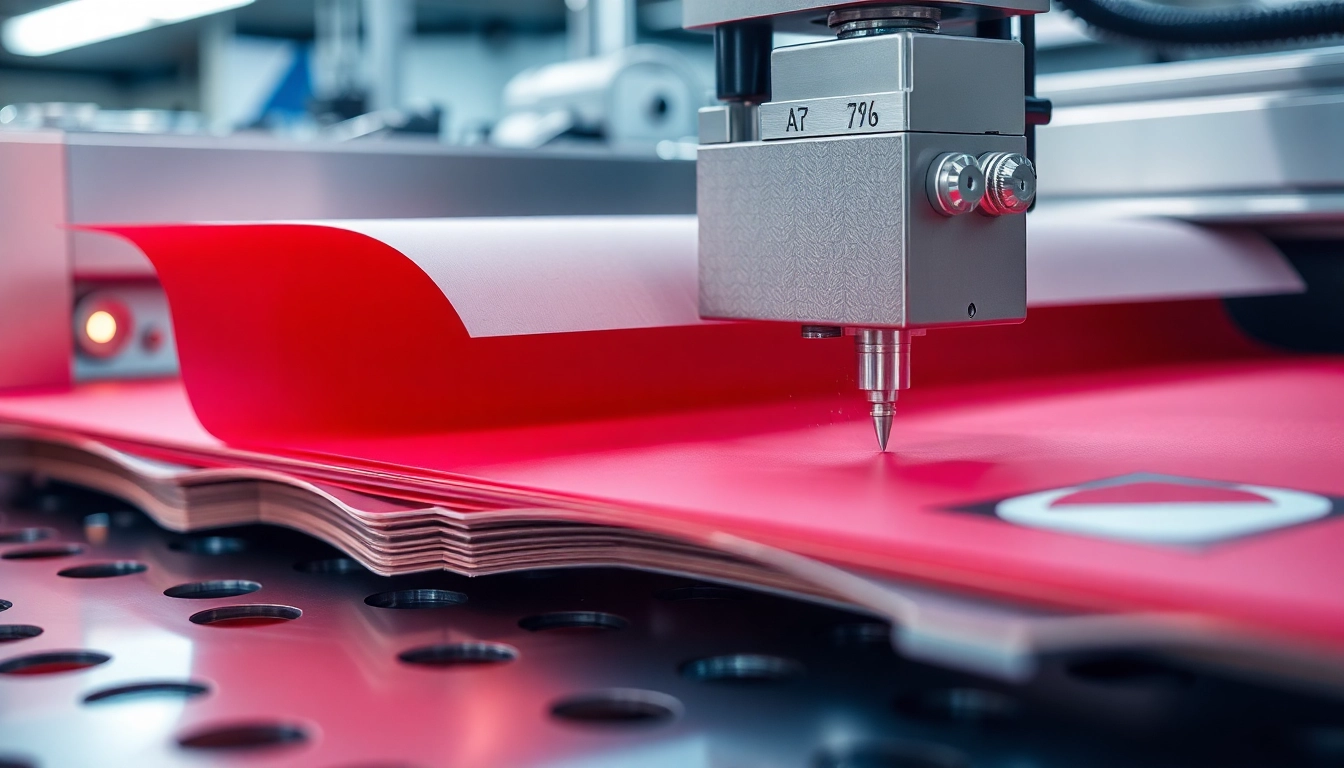Understanding Precision Die Cutting
What is Precision Die Cutting?
Precision die cutting is a manufacturing process that utilizes specialized equipment to accurately cut materials into specific shapes and sizes. This technique is utilized across various industries, enabling the production of intricate designs with tight tolerances. The process typically involves the use of a die—a sharp metal tool—that is pressed onto sheets or rolls of material to achieve a desired cut. The most common materials used in precision die cutting include paper, plastic, foam, rubber, and metals, making it a versatile option for manufacturers. Precision die cutting provides not only speed and efficiency in production but also ensures high levels of consistency and accuracy.
Key Benefits of Precision Die Cutting
The advantages of precision die cutting are numerous and can significantly impact product quality and production efficiency. Here are some key benefits:
- Accuracy: With the use of highly engineered dies, precision die cutting ensures exact specifications are met, resulting in minimal waste and optimal material usage.
- Speed: The process enables rapid production runs, facilitating quicker turnaround times for orders, which is critical in today’s fast-paced market.
- Cost-Effectiveness: While there is an upfront investment involved in the creation of the die, precision die cutting often reduces production costs over large volumes, providing substantial savings in the long run.
- Versatility: This method can be applied to a variety of materials, allowing manufacturers to create diverse products tailored to specific industry needs.
- Complex Designs: Precision die cutting supports intricate patterns that would be difficult or impossible to achieve with other cutting methods.
Common Applications and Industries
Precision die cutting is employed in a multitude of industries, reflecting its versatility and the range of applications it supports:
- Automotive: Used in the production of gaskets, seals, and insulation materials to enhance vehicle performance and safety.
- Medical Device Manufacturing: Vital for creating custom components for devices, bandages, and surgical supplies that require strict adherence to specifications.
- Packaging: Precision die cutting is often utilized to produce custom packaging solutions that not only protect products but also enhance brand presentation.
- Electronics: Commonly used for cutting insulation materials and components used in circuit boards and electronic devices.
- Textiles: Employed in the fashion and upholstery industries to cut fabrics into intricate shapes and patterns needed for apparel and furniture.
Methods of Precision Die Cutting
Flatbed Die Cutting Overview
Flatbed die cutting is one of the fundamental methods used in precision die cutting. This approach involves a flatbed press where the die is mounted on a flat surface. The material to be cut is placed beneath the die, and hydraulic or mechanical pressure is applied to cut through the material. Flatbed die cutting is particularly effective for thicker materials and is commonly used in packaging applications.
Rotary Die Cutting Process
Rotary die cutting utilizes cylindrical dies that rotate to cut the material as it moves through the machine. This method is highly efficient and is ideal for large-scale production runs. Rotary die cutting is often favored in the production of labels, stickers, and other products requiring high-speed cutting. It allows for continuous material feed, reducing the time needed to switch between jobs compared to flatbed processes.
Laser Die Cutting Technology
Laser die cutting employs high-powered laser beams to cut through materials with exceptional precision. This method is beneficial for applications requiring intricate designs or when working with materials that are difficult to cut using traditional methods. Laser die cutting offers the advantage of no physical contact with the material, reducing the risk of damage and enabling more intricate details than standard dies can achieve. It also allows for customization and rapid prototyping, making it a popular choice for innovative design solutions.
Choosing the Right Die Cutting Service
Factors to Consider When Selecting a Provider
When choosing a die cutting service, it’s crucial to evaluate various factors to ensure that you partner with a provider that meets your unique needs:
- Capabilities: Assess whether the provider specializes in the specific methods you need, such as rotary, flatbed, or laser die cutting.
- Experience: Opt for companies with a proven track record in your industry. Experience can correlate directly with quality and reliability.
- Technology and Equipment: Investigate whether the service uses state-of-the-art technology that enhances efficiency and production quality.
- Customer Support: Strong communication and support are essential for addressing any challenges that might arise during the process.
Evaluating Quality and Precision Standards
Quality assurance is vital when selecting a precision die cutting service. You should inquire about the precision standards and tolerance levels they maintain. Ideally, the provider should adhere to industry standards such as ISO certifications, which ensure consistent quality management practices. Ask for samples of their past work to evaluate the quality of cuts and the accuracy of the dimensions.
Examining Turnaround Times and Costs
Cost and turnaround time are often crucial to project success. Evaluate the provider’s pricing structure, including costs associated with die creation and production runs. Understand their typical lead times and whether they can accommodate expedited requests if necessary. Finding a balance between cost, quality, and time is essential for efficient production.
Best Practices in Precision Die Cutting
Designing for Maximum Efficiency
To optimize the die cutting process, designs should be created with efficiency in mind. This includes minimizing waste by maximizing material usage through strategic layouts. Additionally, designs should account for the capabilities of the cutting method being employed—ensuring shapes and patterns are well within the tolerances of the chosen method.
Understanding Material Selection
The choice of material significantly influences the effectiveness of precision die cutting. Different materials behave differently under cutting processes, impacting factors like wear on the die and the quality of the final product. It’s essential to collaborate closely with your die cutting service provider to select the most suitable materials that align with the end-use of your products.
Maintaining Equipment and Tools
Regular maintenance of die cutting equipment ensures consistent performance and longevity. Providers should have scheduled maintenance plans in place for their machines, preventing unexpected downtimes and production delays. High-quality dies should also be properly cleaned and maintained to uphold cutting specifications.
Future Trends in Precision Die Cutting
Innovation in Die Cutting Technologies
The precision die cutting industry continues to evolve with advancements in technology. Innovations such as digital die cutting and automation are gaining traction, leading to increased efficiency and innovation in product offerings. Digital die cutting removes the need for physical dies, allowing real-time adjustments and enhanced production flexibility.
Sustainability and Eco-Friendly Practices
As industries increasingly focus on sustainability, the precision die cutting sector is adopting eco-friendly practices. This includes utilizing recyclable materials, reducing waste in the production process, and pursuing energy-efficient manufacturing technologies. Choosing sustainable practices not only benefits the environment but can also improve a brand’s reputation and appeal to eco-conscious consumers.
Market Predictions and Growth Opportunities
The demand for precision die cutting is projected to grow, with industries such as packaging and healthcare showing particularly strong demand. Companies can leverage new market trends by diversifying their offerings and exploring new applications for die cutting technology. As businesses adapt to changing consumer needs, identifying growth opportunities in precision die cutting can lead to long-term success.



